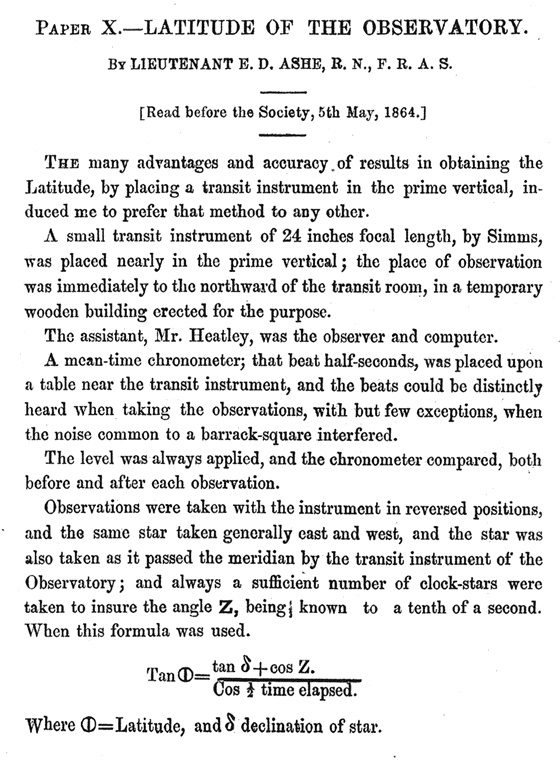Latitude of the observatory of Quebec
By Edward David Ashe
[Originally published by the Literary and Historical Society of Quebec in Transactions, New Series, No. 2 (1864)]
[Read before the Society, 5th May, 1864.]
THE many advantages and accuracy, of results in obtaining the Latitude, by placing a transit instrument in the prime vertical, induced me to prefer that method to any other.
A small transit instrument of 24 inches focal length, by Simms, was placed nearly in the prime vertical ; the place of observation was immediately to the northward of the transit room, in a temporary wooden building erected for the purpose.
The assistant, Mr. Heatley, was the observer and computer.
A mean-time chronometer; that beat half-seconds, was placed upon a table near the transit instrument, and the beats could be distinctly heard when taking the observations, with but few exceptions, when the noise common to a barrack-square interfered.
The level was always applied, and the chronometer compared, both before and after each observation.
Observations were taken with the instrument in reversed positions, and the same star taken generally east and west, and the star was also taken as it passed the meridian by the transit instrument of the Observatory; and always a sufficient number of clock-stars were taken to insure the angle Z, being known to a tenth of a second. When this formula was used.
By reversing the instrument any error of collimation, or inequality of pivots, will produce exactly a contrary effect on the Latitude; and it is presumed that the Latitude of the Observatory is determined with as much accuracy as the declination of the stars arc known.
The stars selected are taken from the B. A. C, 1850, Nat. Alk. and Radcliff Cat., and out of 15 stars with lamp N., and 10 stars taken with lamp South, there is a range of only 1". 3 in the means.
C 2008 Literary and Historical Society of Quebec Tous droits reserves
Site Internet : Pakobrats















